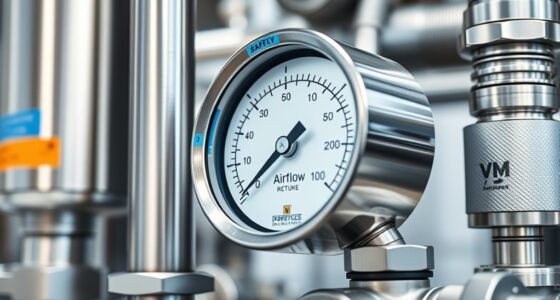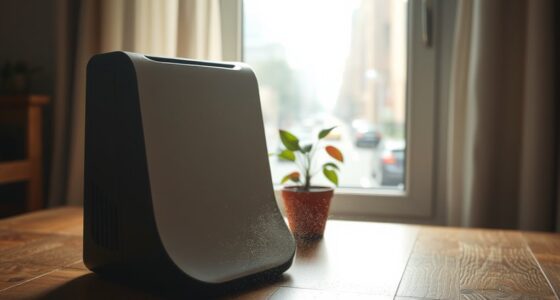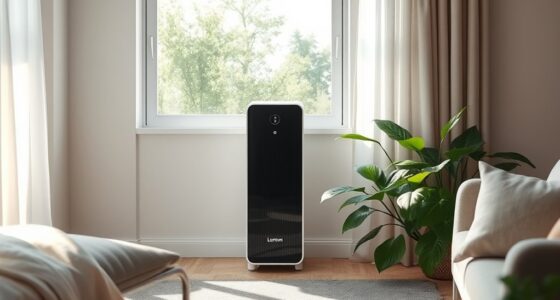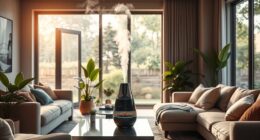Air purifiers work by drawing in air and filtering out harmful pollutants like dust, allergens, and volatile organic compounds. They often use HEPA filters that capture 99.97% of tiny particles, while activated carbon filters tackle gases. Some models even use UV light to kill bacteria and viruses. Regular maintenance and filter replacements are key to ensuring they function effectively. There’s more to discover about how these devices improve air quality in your home.
Key Takeaways
- Air purifiers use filters, such as HEPA and activated carbon, to trap harmful particles and pollutants from the air.
- HEPA filters capture 99.97% of particles 0.3 microns or larger, effectively removing allergens like dust and pet dander.
- Activated carbon filters target volatile organic compounds (VOCs) and gaseous pollutants, contributing to improved indoor air quality.
- Some models feature air-quality sensors that activate purifiers automatically when pollutants are detected, enhancing efficiency.
- Regular maintenance, including filter replacement, is crucial for maintaining optimal air purifier performance and air quality.
Understanding Air Purifier Mechanisms
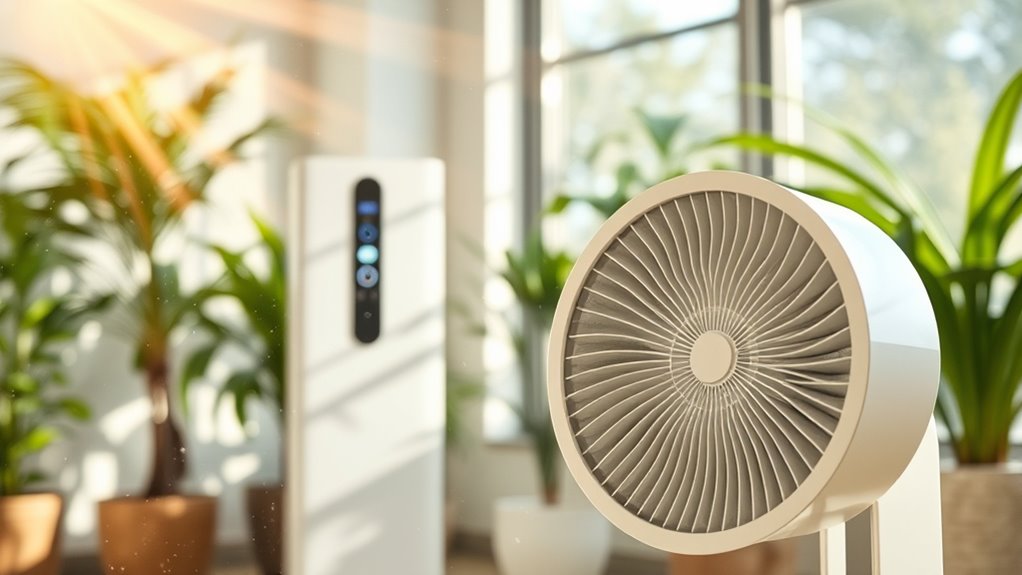
Air purifiers work by actively drawing in air from your environment and filtering out harmful particles and pollutants. They utilize fans to circulate air through various filters designed for specific contaminants.
HEPA filters, for instance, capture at least 99.97% of particles 0.3 microns or larger, making them highly effective for allergens like dust and pollen. Many units also incorporate an activated carbon filter to tackle gaseous pollutants, such as volatile organic compounds (VOCs), which HEPA filters alone can’t handle. Regular use can lead to improved respiratory health, alleviating symptoms of asthma and allergies. Consistent maintenance and cleaning of air purifiers is essential to ensure they operate at peak efficiency. Additionally, many air purifiers now feature advanced filtration systems that enhance the removal of airborne contaminants. Many models also include smart WiFi connectivity for convenient monitoring and control.
The Clean Air Delivery Rate (CADR) is crucial for evaluating an air purifier’s efficiency; higher CADR ratings indicate better performance. Additionally, some air purifiers combine multiple technologies, such as hybrid/combination units, to enhance overall air quality and effectiveness.
Types of Air Purifiers Explained
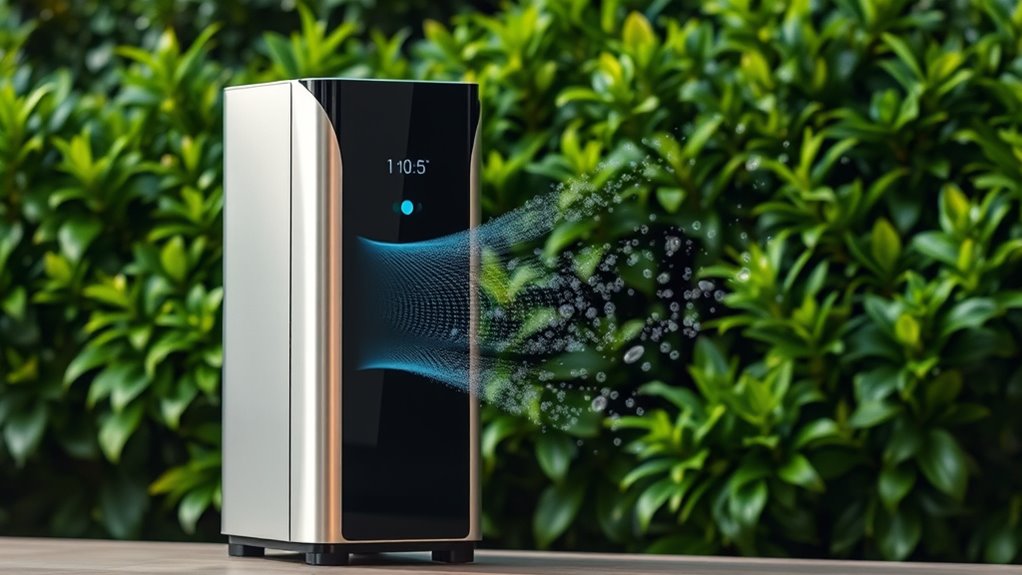
Understanding the different types of air purifiers can help you choose the right one for your needs.
HEPA filters are essential for capturing at least 99.97% of particles sized 0.3 microns or larger, making them highly effective against allergens like dust and pet dander. Additionally, many air purifiers utilize True HEPA filters to ensure maximum efficiency in trapping harmful airborne particles. Regular maintenance, including cleaning filters, is crucial for maintaining their performance over time. Moreover, inadequate maintenance of air purifiers can lead to decreased efficiency, similar to heat pump systems. Multi-functional devices are increasingly popular as they combine various purification technologies to enhance air cleaning capabilities.
HEPA filters capture 99.97% of particles 0.3 microns or larger, effectively targeting allergens like dust and pet dander.
On the other hand, activated carbon filters excel at adsorbing gases and volatile organic compounds (VOCs), which HEPA filters can’t tackle.
You’ll find portable air cleaning devices that use fans to draw air through filters, and whole-house systems that integrate with HVAC systems for consistent air purification. Some models even come with air-quality sensors that activate automatically when pollutants are detected, while smart air purifiers offer real-time air quality reports to help you manage your indoor environment. Additionally, air purifiers with UV light technology enhance the purification process by killing bacteria and viruses, contributing to healthier air quality.
Effectiveness Against Common Pollutants
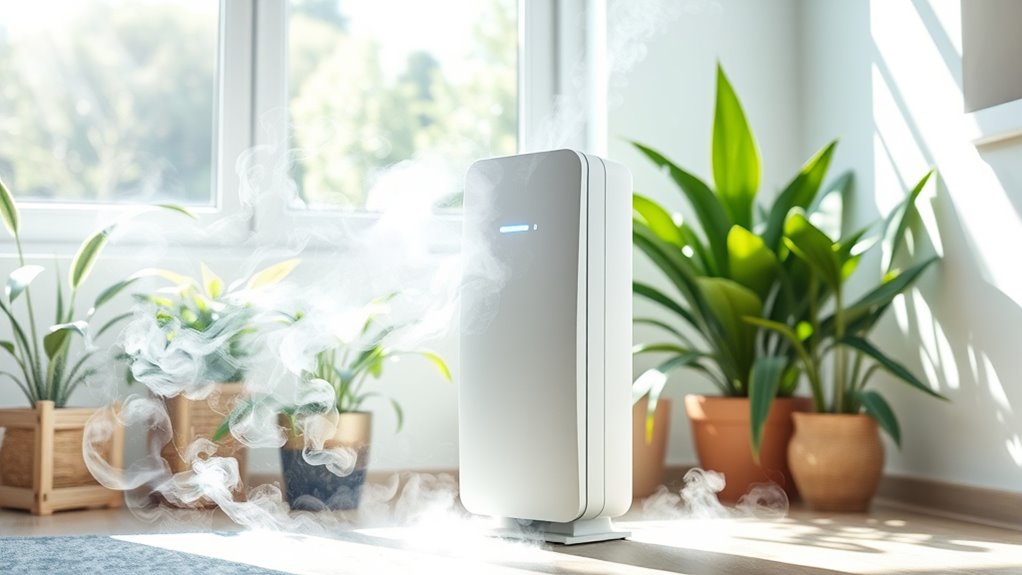
While you might think that all air purifiers are equally effective, their ability to tackle common pollutants varies considerably based on the type of filter they use. HEPA filters excel at capturing allergens like pollen and dust mites, while activated carbon filters are vital for volatile organic compounds (VOCs). It’s essential to recognize that air purifiers can reduce smoke particles but can’t eliminate harmful gases associated with smoking. Mold spores may be captured, yet moisture control is fundamental for preventing mold growth. To help you understand the effectiveness of different air filters, here’s a quick comparison:
| Pollutant | HEPA Filter | Activated Carbon Filter |
|---|---|---|
| Pollen | Yes | No |
| VOCs | No | Yes |
| Smoke Particles | Yes | No |
| Mold Spores | Yes | No |
Additionally, using an air purifier regularly can enhance the overall home hygiene and can be particularly beneficial if you’re also utilizing portable AC units to maintain a comfortable environment in your living space, which can help reduce allergens that contribute to poor indoor air quality. Investing in a vacuum with HEPA filters can further improve air quality by capturing allergens and pet dander in your home. Proper energy efficiency practices, such as sealing air leaks and improving insulation, can also complement air purifiers by reducing the influx of outdoor pollutants.
Debunking Common Air Purifier Myths

You might think air purifiers can solve all your indoor air problems or that your air conditioner is enough to keep the air clean.
However, many misconceptions surround their health benefits and effectiveness. Investment in the right air purifier can significantly improve your indoor air quality and contribute to better overall health. Heat pumps, for example, can also play a role in enhancing indoor air quality by reducing greenhouse gas emissions associated with traditional heating methods. Additionally, maintaining an organized environment can enhance emotional well-being by reducing stress and promoting a sense of calm. Furthermore, heat pumps filter and circulate indoor air, improving air quality through advanced filtration systems.
Let’s clear up these myths to help you make informed decisions about your air quality. Additionally, understanding cookie management options can also enhance your online browsing experience while researching air quality solutions.
Health Benefits Explained
Many people believe that air purifiers can solve all indoor air quality issues, but that’s not entirely true.
While air purifiers equipped with HEPA filters can capture 99.97% of particles as small as 0.3 microns, they primarily target allergens like pollen and pet dander. However, they won’t eliminate allergens embedded in furniture, like dust mites.
Additionally, some ozone-producing models can actually worsen health issues, particularly for those with asthma.
Using HEPA air purifiers can reduce indoor particulate matter considerably, but they’re not a standalone solution. To effectively manage indoor air quality, combine air purifiers with regular cleaning and proper ventilation. This holistic approach will guarantee you get the most out of your air purifier while addressing health issues. Furthermore, incorporating best home security systems can help ensure a safe environment while focusing on air quality.
Air Conditioner Misconceptions
Understanding how air purifiers work is key to addressing common misconceptions about air conditioning systems. Many people think air conditioners alone can improve indoor air quality, but that’s misleading.
While air conditioners help regulate temperature, their basic filters often lack HEPA technology, which means they can’t capture microscopic particles effectively. Air purifiers, on the other hand, excel at trapping particles as small as 0.3 microns, including allergens that standard filters might miss.
Relying solely on air conditioning won’t adequately address indoor pollutants. To truly enhance indoor air quality, consider using air purifiers alongside your air conditioning system. This combination targets various pollutants, ensuring a healthier environment for you and your family.
Alternative Solutions for Indoor Air Quality
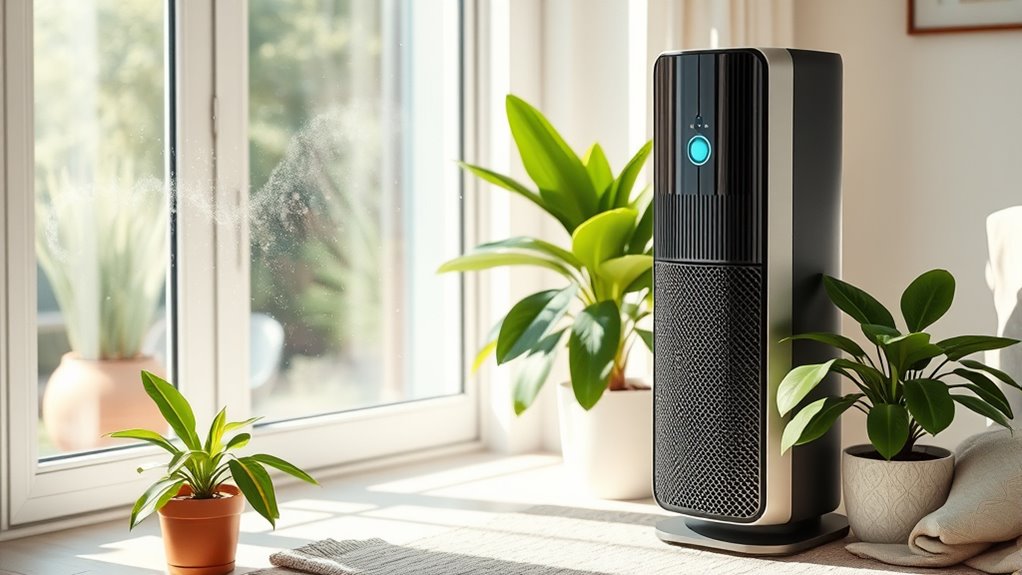
While air purifiers can effectively improve indoor air quality, there are several alternative solutions that can yield considerable results without relying solely on technology.
Start by controlling sources of indoor pollution; switch to non-toxic cleaners and minimize VOC-emitting materials in your home. Regularly clean and dust surfaces, and use a HEPA filter-equipped vacuum to reduce allergen buildup.
Maintaining humidity levels between 30-50% can also help prevent mold growth and dust mites. Improve ventilation by opening windows or using exhaust fans to dilute indoor pollutants naturally.
Although houseplants are popular for air quality, they may not considerably reduce contaminants and can contribute to mold if overwatered.
Focusing on these alternatives can enhance your indoor environment effectively.
The Role of Maintenance in Air Purifier Performance
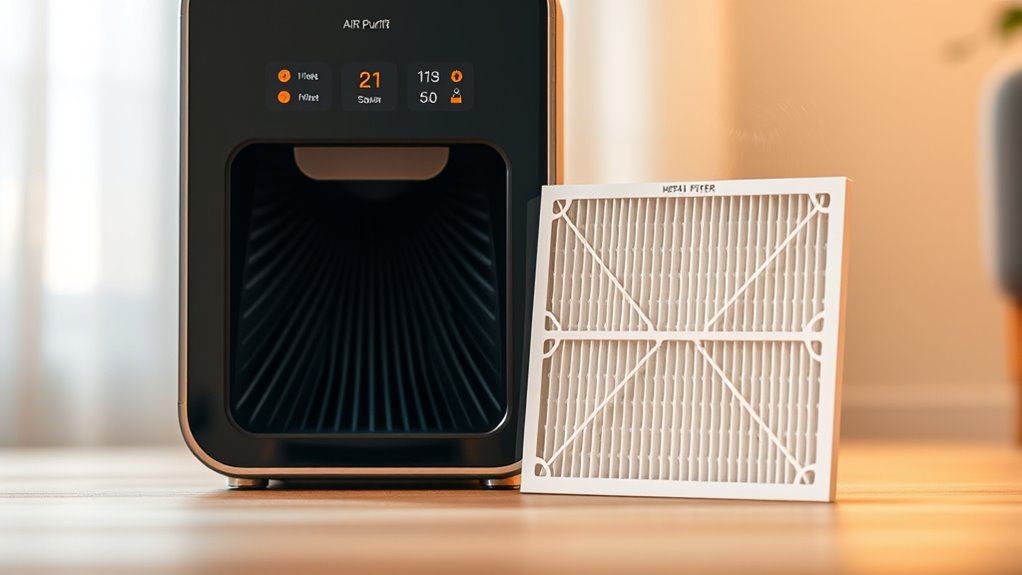
To keep your air purifier running effectively, you need to stay on top of maintenance.
Regularly replacing filters and cleaning components can greatly improve its performance and air quality.
Plus, knowing the best placement strategies can help maximize its efficiency in your space.
Filter Replacement Schedule
When you want to keep your air purifier running at its best, regular filter replacements play an essential role in maintaining its performance. Clogged filters can greatly reduce airflow and effectiveness, so aim to replace HEPA filters every 3 to 6 months, depending on usage.
HEPA filters capture at least 99.97% of particles 0.3 microns or larger, ensuring ideal air quality. If your purifier uses activated carbon filters to absorb odors and VOCs, consider changing them every 2 to 3 months, especially in polluted areas.
To assess when it’s time for a filter replacement, monitor the Clean Air Delivery Rate (CADR); a noticeable drop in CADR signals the need for a change. Some models even feature indicators for timely replacements.
Regular Cleaning Practices
Maintaining your air purifier goes beyond just replacing filters; regular cleaning practices are essential for ideal performance. Dust and debris can build up on both the exterior and internal components, obstructing airflow and reducing efficiency. To guarantee peak performance, follow a maintenance routine that includes checking and cleaning the unit regularly.
| Maintenance Task | Frequency |
|---|---|
| Exterior cleaning | Monthly |
| Filter replacement | Every 3 to 6 months |
| Interior component check | Every 3 months |
| Overall unit inspection | Every 6 months |
Neglecting these cleaning practices can lead to clogged filters and decreased Clean Air Delivery Rate (CADR), ultimately releasing trapped contaminants back into the air. Stay proactive to maximize your air purifier’s effectiveness!
Optimal Placement Strategies
Ideal placement of your air purifier can greatly enhance its performance, ensuring cleaner air in your living space.
For best placement, position the unit away from walls and furniture to promote better air circulation and filtration efficiency. Air purifiers work best in smaller, enclosed spaces, as their effectiveness decreases in larger areas where pollutants can get diluted.
To maintain air purification, run your purifier continuously during high pollen seasons or when indoor pollutants rise.
Regular maintenance is key; replace filters every 6 to 12 months and clean pre-filters or the exterior often to prevent dust buildup. This enhances airflow, ensuring your air purifier operates at its finest for a healthier home environment.
Frequently Asked Questions
Are There Any Proven Benefits to Air Purifiers?
Yes, there are proven benefits to air purifiers.
When you use one with a HEPA filter, it can capture 99.97% of particles like pollen and pet dander, greatly reducing allergens in your space.
Studies show that consistent use can lower indoor PM 2.5 levels by over 50%, improving air quality and potentially easing respiratory issues.
However, remember to combine their use with regular cleaning and ventilation for the best results.
What Do Doctors Say About Air Purifiers?
Doctors generally recognize that air purifiers can help reduce indoor allergens like dust, pollen, and pet dander, making it easier for you to breathe if you suffer from allergies.
They highlight that HEPA filters are effective, capturing 99.97% of particles larger than 0.3 microns.
However, they caution that air purifiers shouldn’t replace regular cleaning and humidity control.
For those concerned about gases, choosing a purifier with activated carbon filters is essential.
Do Air Purifiers Actually Make a Difference?
Imagine breathing in crisp, clean mountain air, free from allergens and pollutants.
That’s what air purifiers can do for you. They’re designed to capture dust, pollen, and pet dander, markedly improving your indoor air quality.
If you suffer from asthma or allergies, using one can reduce your symptoms. While they won’t eliminate every virus, they still make a noticeable difference, especially when paired with good ventilation.
Investing in one is definitely worthwhile!
What Are the Dark Side of Air Purifiers?
When you consider the dark side of air purifiers, you might find some surprising drawbacks.
They can struggle with certain pollutants like mold and VOCs, especially without proper cleaning and moisture control. Some models emit ozone, which can worsen respiratory issues.
Plus, if you don’t maintain them—like changing filters regularly—they may circulate contaminants instead of removing them.
It’s essential to choose the right type for your space and needs to maximize their effectiveness.
Conclusion
In a world where dust and allergens swirl like unseen ghosts, air purifiers stand as your silent guardians, filtering out the chaos. While some myths cast shadows on their effectiveness, the truth reveals a powerful ally in your quest for clean air. Just like a lighthouse cutting through fog, these devices illuminate your indoor environment, but remember: without regular maintenance, even the brightest light dims. Embrace your air purifier, and let it transform your space into a sanctuary of fresh air.


